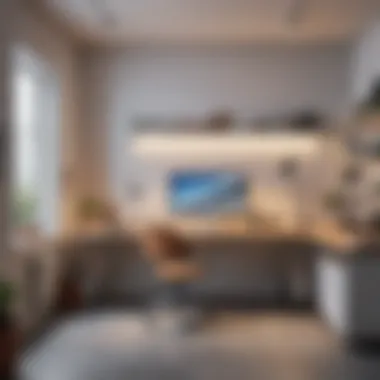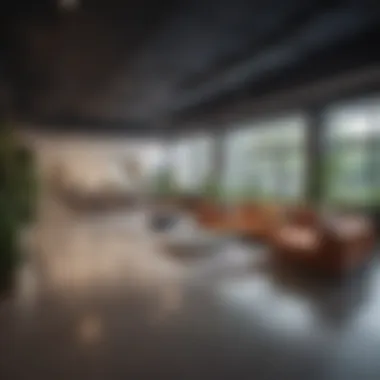The Need for Room: Space in Architecture and Design


Intro
In architecture and design, the concept of space plays a crucial role. It affects how buildings function and how people feel within them. This article investigates the need for room, emphasizing how the management of space can enhance both functionality and aesthetic appeal. Understanding these dynamics can profoundly impact the designs we choose, both for our homes and work environments.
Space is not just an empty void; it carries weight and significance. The layout of a room influences its usability and can evoke emotional responses. Homeowners and designers alike must pay attention to how space is allocated, as it significantly affects the quality of life.
Furthermore, this exploration will highlight different architectural philosophies that consider space as a central element. From minimalist designs to spacious open concepts, the approaches are varied but united in their commitment to thoughtful design.
This article is structured into several sections, providing insights and practical strategies for maximizing the potential of space in any setting. The discussions will cater to real estate enthusiasts, travel lovers, and interior design aficionados, offering valuable takeaways to create inspiring harmony in living and working environments.
In the following sections, we will delve into specific examples of featured homes, understanding how architectural highlights and interior design themes can create meaningful spaces.
Understanding the Concept of Space
The concept of space in architecture and design is not simply about the physical dimensions of a room. It plays a crucial role in how people interact with their environments. This section seeks to elaborate on the various dimensions of space, including how it shapes functionality, fosters aesthetic appeal, and influences psychological well-being.
Understanding space allows designers to create environments that enhance both practicality and comfort. How spaces are defined and utilized can significantly affect their overall effectiveness. For instance, a room designed with clear purposes often improves the functionality and utility of that area.
Additionally, interpreting space involves appreciating cultural nuances and societal contexts. Different cultures perceive spatial boundaries uniquely, which reflects their values and lifestyle preferences. Recognizing this can enrich design choices, producing spaces that resonate more deeply with their users.
Defining Space in Design
Defining space in design involves an exploration of both physical and conceptual attributes. Physical space can refer to the measurements and layout of a room, whereas conceptual space encompasses how space is perceived and experienced. The definition often dictates the overall feel of an architecture or design project.
Key considerations include:
- Dimensions: The height, width, and length create the physical boundaries.
- Flow: How individuals move through space impacts its functionality.
- Zoning: Distinguishing areas for specific activities.
Each of these components collectively contributes to an understanding of how a space can be defined and effectively utilized.
Cultural Perspectives on Space
Cultural perspectives on space are crucial in the design process. Space is often interpreted differently across cultures. For example, in Western contexts, personal space tends to be highly valued, where physical boundaries are important for comfort. In contrast, many collectivist cultures prioritize communal spaces, where the emphasis is on shared experiences.
Some ideas to consider include:
- Variations in Spatial Needs: Different regions have unique preferences for space utilization.
- Symbolism of Space: Cultures might imbue specific areas with meaning, such as reverence for entryways.
- Spatial Hierarchies: Certain spaces might reflect social rankings or hierarchies within a culture.
Incorporating these perspectives into design creates environments that are not only functional but also culturally resonant.
Psychological Impacts of Space
Recognizing the psychological impacts of space reveals its importance in architecture and design. Space can influence mood, behavior, and overall well-being. For instance, an open and airy room may lead to feelings of freedom and relaxation, while cramped spaces can induce stress and anxiety.
Important psychological factors include:
- Natural Light: Well-lit spaces promote energy and positivity.
- Color Choices: Colors can evoke specific emotional responses, affecting the ambiance.
- Layout: Arranging furniture and spaces thoughtfully can improve interaction and comfort.
In summary, understanding space is vital in architecture and design to create supportive environments that acknowledge diverse cultural perspectives and enhance psychological well-being.
The Importance of Room in Living Environments
The concept of room within living environments transcends mere physical boundaries. It signifies the very essence of functionality, comfort, and aesthetic appeal. Understanding the importance of room can significantly enhance both residential and commercial spaces. In contemporary society, where the pressures of urban living are ever-increasing, it becomes imperative to decipher how optimal space management influences our everyday experiences.
Benefits of Thoughtful Space Design
Effective space management contributes to a sense of well-being and satisfaction. A well-designed room caters to both the functional needs of its occupants and offers an inviting ambiance. This duality leads to improved productivity in workspaces and increased relaxation in homes. Studies show that environments, which provide adequate room for movement and interaction, directly impact psychological health.
Functional Space: Making the Most of Every Room
In architecture and design, functional space is critical for maximizing utility. Every room should serve a distinct purpose while allowing flexibility where needed.
- Adaptable Solutions: Incorporating features that allow rooms to serve multiple functions is vital. For example, a living room can double as a workspace.
- Efficient Layouts: Harmony in spatial planning ensures that necessary furniture and fixtures fit seamlessly. This consideration reduces clutter, which can impede functionality.
By utilizing innovative design strategies, such as open shelving systems and modular furniture, owners can transform a standard space into a versatile environment. This adaptability elevates the living experience, making each room functional without sacrificing comfort.
Aesthetic Value: Designing for the Eye


Interior design inherently connects to aesthetic value. The right design choice can greatly enhance the enjoyment of a space. Colors, textures, and patterns play critical roles in creating an inviting atmosphere.
- Color Theory: Colors can evoke different emotions. Warm tones create a cozy environment, while cool tones may promote calmness.
- Material Selection: Choice of materials impacts visual appeal. Natural materials, like wood and stone, tend to enhance the aesthetic quality, linking the indoors and outdoors effectively.
Designing a room with the eye in mind adds another layer of enjoyment to living. Whether a space is airy and light or warm and intimate, aesthetic value affects how we interact within it.
Balancing Functionality and Beauty
Achieving balance between functionality and beauty is a challenge in room design. A space should not only be serviceable but also aspirational. This balance requires keen understanding of individual needs.
- Personal Touch: Incorporating personal elements such as art or family memorabilia allows for a unique character, marrying functionality with individuality.
- Smart Design Choices: Integrating advanced technologies can enhance functionality without compromising style. For example, using sleek, modern appliances in a traditional kitchen.
Functional beauty creates environments that are both practical and visually appealing. Attention to detail in room design ensures a cohesive flow, fostering a space where occupants can thrive.
"The essence of design is achieving harmony between what works and what inspires."
Innovative Design Strategies for Optimizing Space
In modern architecture and design, optimizing space has become an essential focus. With urban areas expanding and living spaces becoming more compact, effective space management has significant implications for functionality, aesthetics, and overall well-being. The following discusses innovative design strategies that address these needs and considerations, notably highlighting the need for adaptation in diverse environments.
Open Floor Plans vs. Traditional Layouts
Open floor plans have gained popularity in recent years. These designs are known for merging spaces, like the kitchen, dining, and living areas. This layout promotes social interaction and gives a sense of spaciousness.
- Benefits of Open Floor Plans:
- Enhances natural light circulation
- Encourages family engagement and flexibility
- Makes smaller areas feel larger
However, traditional layouts have their merits as well. They offer defined rooms that can be more functional for specific activities.
- Benefits of Traditional Layouts:
- Provides privacy and quiet during activities
- Allows for space customization per room’s purpose
- Easier to decorate and furnish distinct areas
The choice between open and traditional layouts largely depends on the lifestyle of the inhabitants and their specific needs.
Multi-Purpose Rooms: Versatility in Design
The concept of multi-purpose rooms highlights versatility in design. These spaces serve different functions depending on the time of day or need. A room can transform from a home office to a guest bedroom seamlessly. This adaptability is beneficial in smaller homes.
- Key Features of Multi-Purpose Rooms:
- Furniture that can be easily reconfigured
- Storage solutions that minimize clutter
- Areas that can serve multiple activities, like a combination of workout and relaxation space
Implementing multi-purpose rooms requires innovative thinking to ensure that each function is accommodated effectively.
Smart Storage Solutions for Small Spaces
In small living environments, storage solutions serve a crucial role in optimizing space. The lack of room necessitates practical and efficient ways to store belongings without sacrificing style or accessibility.
- Effective Smart Storage Ideas:
- Vertical Storage: Using wall space for shelves and cabinets
- Under-Furniture Storage: Utilizing the spaces beneath beds and couches
- Modular Furniture: Buying pieces that serve dual purposes, like an ottoman with storage inside
These storage solutions enhance not only efficiency but also contribute to a cleaner, organized living environment, which is vital for comfort and psychological well-being.
"The key to effective room design is understanding the interaction between function and form."
Architectural Trends Influencing Room Design
Understanding architectural trends is essential for anyone involved in the design and planning of spaces. These trends are not merely aesthetic choices but reflect deeper shifts in societal values, lifestyle needs, and environmental considerations. The evolving definition of what a room should be drives how spaces are constructed and used.
Minimalism: Less is More
Minimalism emphasizes simplicity and functionality. This approach strips away excess, focusing on what truly matters in a space. Minimalism enhances perception by providing clear lines and uncluttered environments. A well-designed minimalist space can feel larger and more inviting. The absence of distractions allows the user to appreciate the essential features.


Key Elements of Minimalism:
- Neutral Palettes: Use of whites, beiges, and soft grays creates calm.
- Functional Furniture: Multi-use furniture contributes to utility.
- Natural Light: Large windows foster openness and connectivity to the outside.
The minimalist approach is not suitable for everyone, but it presents an attractive option for those seeking clarity and serenity in their spaces.
Sustainable Design: Eco-Friendly Spaces
Sustainable design takes into account the ecological impact of building practices. In an era where environmental concerns are paramount, incorporating sustainable elements into room design is critical. This approach not only minimizes waste but also promotes the use of materials that are recyclable or sourced sustainably.
Benefits of Sustainable Design:
- Resource Efficiency: Saves energy and reduces costs in the long run.
- Indoor Air Quality: Better materials improve health by reducing toxins.
- Long-term Viability: Well-planned sustainable designs stand the test of time.
This trend is gaining momentum in residential and commercial projects, reflecting a shift towards conscious consumerism. Designers who embrace sustainability help create spaces that promote well-being while respecting the environment.
Biophilic Design: Connecting with Nature
The concept of biophilic design is based on the idea that humans have an inherent need to connect with nature. This design philosophy integrates natural elements into built environments to enhance the well-being of occupants. The benefits are profound, affecting mood, concentration, and overall health.
Ways to Implement Biophilic Design:
- Natural Materials: Use of wood, stone, and other organic materials adds warmth.
- Indoor Plants: Incorporating greenery brings life to interiors and improves air quality.
- Natural Light: Designs that maximize daylight create a sense of openness and vitality.
Biophilic design is not only a trend but a necessity in today's built environments. Bringing the natural world indoors helps to balance the often sterile feeling of modern spaces, creating a more human-centered approach to room design.
"Incorporating nature into room design is not merely aesthetic but essential for holistic well-being."
The Role of Color in Spatial Perception
Color plays a crucial role in how individuals perceive space. It can enhance or diminish the feeling of openness and encourage specific emotions. In architecture and design, understanding the role of color is essential to create environments that feel inviting and harmonious. Color influences not only the aesthetics of a space but also affects how occupants interact with their surroundings.
Understanding Color Theory
Color theory is the foundation of how colors combine and relate to one another. It encompasses various aspects, such as the color wheel, color harmony, and the psychological impacts of color.
- The Color Wheel: This visual representation highlights primary colors like red, blue, and yellow, along with secondary and tertiary colors. Designers use the color wheel to make decisions about color combinations to create mood and depth.
- Color Harmony: This concept refers to the pleasing arrangement of colors. Complementary (opposite colors) and analogous (next to each other) color schemes are often employed to create balance in a room.
- Psychological Effects: Different colors evoke varying emotions. For instance, blue can induce calmness, while yellow may energize. Understanding these principles can guide designers in using color to impact moods effectively.
Creating Illusion of Space with Color
Using color strategically in design can create the illusion of more space. Lighter colors often make environments feel more spacious, while darker hues can make a room appear smaller and more closed in. Here are some methods to create spatial perception with color:
- Light Tones: Light shades, like pastels or whites, reflect more light, resulting in a airy feel. These colors work well in smaller rooms or areas that lack natural light.
- Accent Walls: A bold color on one wall can create depth without overwhelming the entire space. This contrasts can draw the eye and elongate the room visually.
- Ceiling Color: Painting ceilings a lighter hue than the walls can create a feeling of height, making spaces feel roomier.
"Color is the keyboard, the eyes are the harmonies, the soul is the piano with many strings." – Wassily Kandinsky
Color Choices for Different Rooms
Choosing suitable colors for specific rooms requires considering their function and ambiance. Certain colors may fit better in some areas than others:
- Living Rooms: Warm colors, like soft oranges or earthy browns, tend to create a welcoming atmosphere for socializing.
- Bedrooms: Cooler tones, such as blues or greens, promote relaxation and tranquility, ideal for sleep.
- Kitchens: Bright and cheerful colors, like yellows or whites, stimulate appetite and energy.
- Home Offices: Neutrals with pops of energizing colors can boost productivity while maintaining focus.
By applying these insights into color choices, designers can carefully manipulate perceptions of space and create environments that resonate with users on both functional and emotional levels.
Case Studies: Room Design in Action
Analyzing case studies in room design offers significant insights into practical applications of theoretical concepts discussed in architecture and design. This section highlights the real-world impact of design choices and the varying outcomes derived from diverse approaches to creating spaces. Understanding these outcomes helps professionals and enthusiasts glean lessons from successful designs while avoiding potential pitfalls in their own projects.
Analyzing Successful Residential Designs
Successful residential designs often showcase innovative uses of space. These spaces can serve as models for future projects. A few essential elements emerge when analyzing these designs:
- Functional versatility: Homes that adapt to changing needs can maintain their relevance over time. Integrating multipurpose furniture facilitates this flexibility. The idea is to create zones within a space that serve various functions without feeling congested.
- Natural light: The effective use of windows and skylights enhances the emotional tone of residential areas. Light can alter perceptions of room size and atmosphere, significantly impacting inhabitants’ mood and comfort.
- Flow and circulation: Good residential design considers how people move through a space. Open floor plans allow for a seamless transition between areas. Be mindful of how furniture placement affects pathways and accessibility.
Evaluating real-life examples provides criteria for assessing how well these elements are executed in residential settings.


Commercial Spaces: Maximizing Functionality
When it comes to commercial design, maximizing functionality is paramount. It is essential to consider how space affects employees and clients. Successful commercial designs often prioritize:
- Work efficiency: An office layout that accommodates team collaboration and individual productivity is crucial. Perhaps implementing an open layout with designated quiet areas can enhance performance.
- Client interaction: The arrangement of spaces needs to facilitate a positive experience for clients. Reception areas should convey professionalism and comfort, while meeting spaces must promote effective communication.
- Adaptability: Businesses evolve, and so should their spaces. Designing with future growth in mind allows companies to avoid costly renovations. Movable walls and flexible furniture can enable quick re-configurations.
These elements showcase the responsibility of commercial designers to deliver spaces that serve multiple stakeholders.
Inspirational Global Examples
Global inspiration can inform local approaches to room design. Examples from different cultures can provide fresh perspectives on space management and aesthetics. Consider:
- Japanese Tatami Rooms: These traditional spaces prioritize simplicity. The tatami mats serve as flexible flooring options that can accommodate various activities, adapting to users’ needs.
- Scandinavian Minimalism: In Nordic countries, the emphasis on functionality is paramount. Clean lines and muted colors create spacious illusions, making rooms feel airy and inviting.
- Mediterranean Open-Plan Living: In warmer climates, homes often embrace open layouts that connect indoor and outdoor areas, enhancing the spatial experience. Large windows and terraces integrate natural elements seamlessly.
Learning from these diverse examples encourages a broader understanding of how different cultures approach the concept of space. Applying these lessons can lead to more innovative and meaningful designs in various contexts.
Technological Innovations in Room Design
Technological innovations have revolutionized room design, expanding the horizons of what is possible in architecture and interior design. As society becomes more reliant on technology, integrating these advancements into living and working spaces is crucial. This section discusses three prominent areas of technological innovation that significantly impact room design: smart home technology integration, virtual reality, and 3D modeling.
Smart Home Technology Integration
Smart home technology has emerged as a pivotal element in modern room design, offering convenience, efficiency, and enhanced security. This technology connects various devices within a home, allowing for seamless control through smartphones or voice-activated systems. Some key benefits of smart home technology include:
- Energy efficiency: Smart thermostats and lighting systems can adjust settings based on user behavior, helping reduce energy consumption.
- Enhanced security: Smart locks, cameras, and alarms enable homeowners to monitor their properties remotely, providing peace of mind.
- User convenience: Automated systems can manage everything from heating to entertainment systems, simplifying daily routines.
While integrating smart technology, designers must consider user experience, ensuring that systems are intuitive and fitting to the aesthetic of the space. This thoughtful integration promotes functional and enjoyable environments.
Virtual Reality in Interior Design
Virtual reality (VR) is transforming the way interior designers conceptualize and present their ideas. By creating immersive environments, VR allows clients to explore spaces before any physical changes occur. This technology offers several advantages:
- Enhanced visualization: Clients can experience how design elements work together in a simulated environment.
- Decision-making ease: By walking through a virtual model, clients may feel more confident making choices, reducing costly mistakes later.
- Effective communication: Designers can convey complex ideas more clearly, fostering better collaboration with clients.
Despite its benefits, the use of VR must consider accessibility issues. Not all clients may be comfortable with the technology, so offering various ways to view designs remains essential.
3D Modeling for Effective Planning
3D modeling has become a standard practice in room design, enabling designers to represent spaces accurately and efficiently. This technology allows for dynamic planning, visualization, and testing of design concepts. Key points regarding 3D modeling include:
- Precision: Detailed models provide an accurate representation of scale and proportions, minimizing errors in construction.
- Flexibility: Designers can easily explore changes and adjustments, improving the overall design process.
- Client engagement: 3D models enhance communication by providing clear visuals that clients can understand.
The integration of these technological advancements into room design underscores the need to balance innovation with practicality. New technologies can dramatically improve how spaces are designed, but they must be implemented with a clear understanding of the user experience and design goals.
Epilogue: The Future of Room in Design
In the realm of architecture and interior design, the concept of room and its spatial parameters are continuously evolving. This article emphasizes the necessity to critically examine the evolving needs of space. As social behaviors, technologies, and environmental considerations shift, so too should our understanding of how room influences human experience.
Evolving Concepts of Space
Over time, our relationship with space has undergone significant transformation. Traditional views of spacious areas often revolved around grand structures and expansive layouts. However, modern architectural trends are shifting focus towards efficiency and sustainability.
Individuals are increasingly valuing flexible spaces that adapt to their lifestyles. Open layouts, which once suggested a lack of privacy, now offer opportunities for connection while still providing necessary segregation through furniture placement or movable partitions. Incorporating modular design encourages users to customize their environments, allowing for responsiveness to changing needs. This reflects a broader trend towards creating multifunctional areas that can accommodate varied activities, from work to leisure.
The Continuing Importance of Room
The need for room in design is paramount, not merely for aesthetics but for enhancing psychological well-being. Studies show a strong connection between physical spaces and mental health. Environments that feel cramped or uninspired can lead to stress and dissatisfaction. Therefore, extending thoughtful design principles into both residential and commercial contexts can be beneficial.
By prioritizing spaciousness, both physically and mentally, people can experience greater comfort and functionality. It is essential for architects and designers to integrate elements that foster a sense of openness. This could mean ensuring adequate natural light, ventilation, or soothing color palettes that can influence mood positively.
"Room is not merely an area but a realm of possibilities for creativity and comfort."
Final Thoughts on Designing for Space
As we embrace the future of design, the key lies in recognizing the dynamic nature of room accessibility. The vision of room needs to encompass not only how we design spaces, but also how these spaces serve individuals and communities.
The integration of technology and sustainable practices into space management will play a crucial role in shaping future architectural endeavors. Smart technologies can help maximize functionality, while sustainable materials enhance the aesthetic value.
Moreover, it is necessary to appreciate the cultural distinctions in how room is perceived and utilized. Different regions have unique standards and practices that contribute to a diverse understanding of spatial concepts.
Ultimately, designing for space should not be seen as a mere guideline. Instead, it should be viewed as an ongoing dialogue among architects, designers, and the users who inhabit these spaces. Moving forward, this conversation will define the spaces we create, ensuring they resonate with the values, needs, and aspirations of their occupants.







